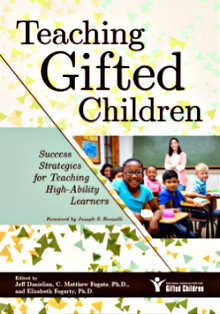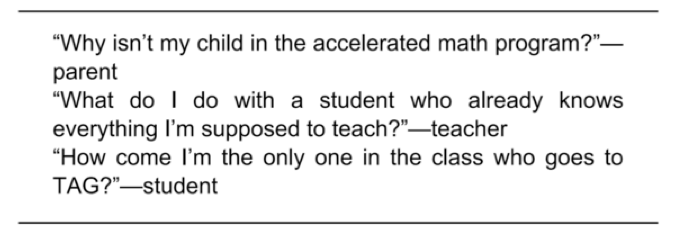An Outstanding Resource for Teaching Gifted Kids
Teaching Gifted Children: Success Strategies for Teaching High-Ability Learners
Edited by C. Matthew Fugate, Ph.D., Jeff Danielian, Elizabeth Fogarty, Ph.D.
(Prufrock Press, 2018 – Learn more)

According to the National Association for Gifted Children, “Children are gifted when their ability is significantly above the norm for their age. Giftedness may manifest in one or more domains such as: intellectual, creative, artistic, leadership, or in a specific academic field such as language arts, mathematics, or science.”

This magnificent, comprehensive anthology of gifted research, resources, and teaching strategies was written by experts in the field: teachers. Teachers who shared their insights, successes, roadblocks, and passion for teaching.
Do these quotes resonate in your ears? Have you heard them before?
The book begins with an overview of gifted education, explaining why identifying gifted students is so important, and also provides ideas for developing talent in gifted students.
The next chapters include a guide for student identification and how to effectively use classroom spaces to promote creativity and risk-taking while supporting the gifted student’s social and emotional development. The list doesn’t stop there.
Chapters 15 to 22 discuss curriculum planning and thinking, while Section Five delves into each of the curriculum areas: language arts, mathematics, visual/ performing arts, history/social studies, and science. In addition, there is an extensive library of articles that provide support for educators, culturally diverse students, students who also have other special needs, and LGBTQ students who are gifted.
Reaching underrepresented gifted students
As educators we are always looking for ways to reach our students and ensure the needs of all are met. But many general education teachers have had limited coursework in gifted education and few opportunities for professional learning. (Macguire, 2008; Mendoza, 2006; Reis, Gubbins, Briggs, Schreiber, Richards, Jacobs, Eckert, Renzulli, & Alexander, 2003)
There are many underrepresented gifted students who have not been identified due to their limited English proficiency or backgrounds, and a lack of teachers who have been trained to identify or meet their needs. Often the gifted student is in the regular classroom for most of the day without some key supports. It is critical that school districts provide professional development planning in this area. Making the resources in this book available is a first step toward helping all educators work with gifted children more effectively.
Both experienced and beginning teachers need access to these 578 pages. And don’t let the length of this book scare you. If you are interested in learning more about a particular area, you can zoom right to that section and glean advice from other teachers. It is a resource volume and does not have to be read from cover to cover, page by page. What you do choose to read you will find is thorough, honest, and current, thanks to skillful editing.
Applying current trends in education
Practical, applicable, and easy to read, the articles include current topics in pedagogy as well as current trends such as the use of Makerspaces, Mathematics Olympiads for Elementary Students, Digital Art, STEM and STEAM, and the Next Generation Science Standards.
Because there are so many different articles, you can “pick and choose” the ones that are currently applicable to you. As a result of the variety of topics, you are introduced to a wealth of information that you can take time to reflect upon and apply if applicable.
I strongly recommend this book to colleges and universities with teacher preparatory programs in order that potential educators will have a better understanding of giftedness, how other educators have worked with students in their class, possible problems that may surface, and how veteran teachers were able to solve them.
This book is based on best practices in education and offers insights into classrooms that potential educators may not have the opportunity to experience personally. The articles (drawn from NAGC’s quarterly journal Teaching for High Potential) explain the many facets of giftedness,and offer options that teachers can share with parents and colleagues in order to provide the best programs possible.
As you read the articles, you will gain a better understanding of gifted students and how to help them explore their potential and pursue their passions. It’s a fantastic book to have whether you teach in a gifted education classroom or have gifted students in your regular education classroom. I believe that you will find the book will become a top “go-to resource.”
Linda Biondi recently retired as a fourth grade teacher at Sharon Elementary School in Robbinsville, NJ where she was a long-time Morning Meeting practitioner. She is the recipient of several educational grants, a Teacher Consultant with the National Writing Project, and was a participant on the NJ Department of Education Teacher Advisory Panel and with ECET2 Celebrate Teaching. In 2018 she begins supervising student teaching and consulting.



































